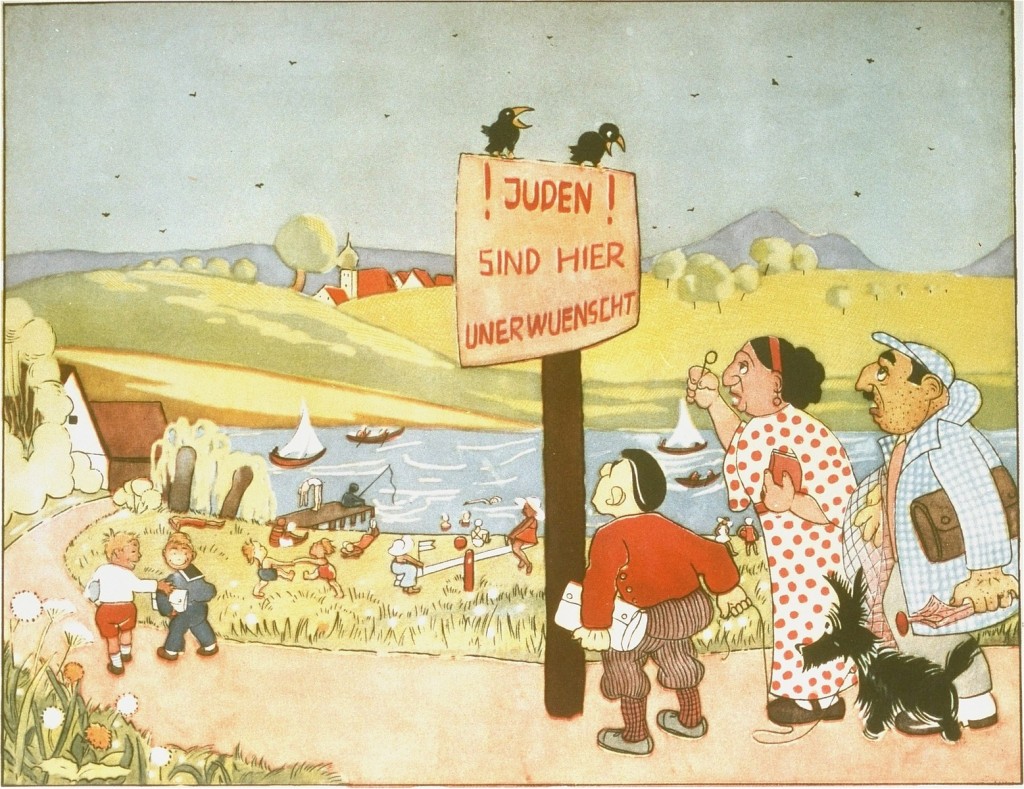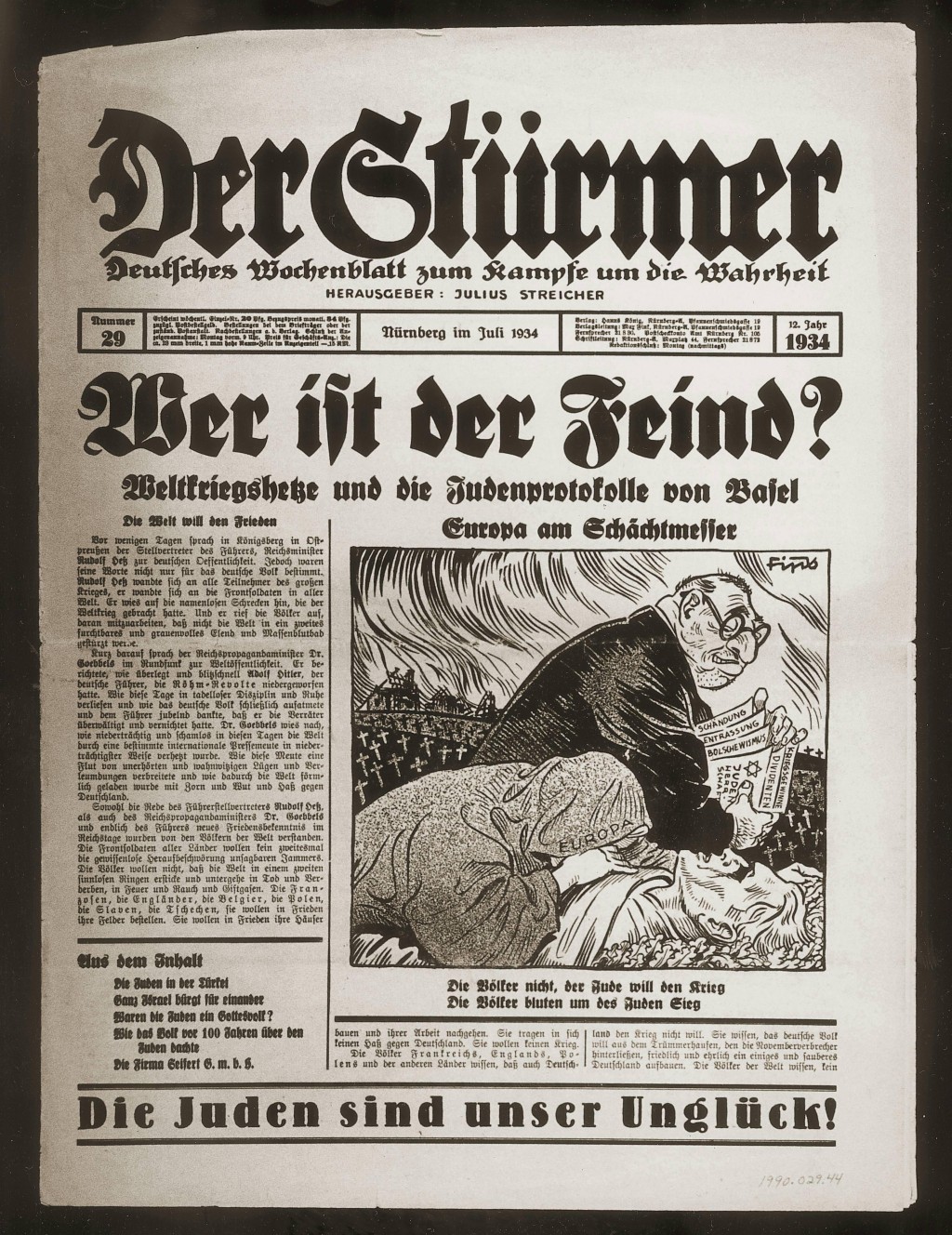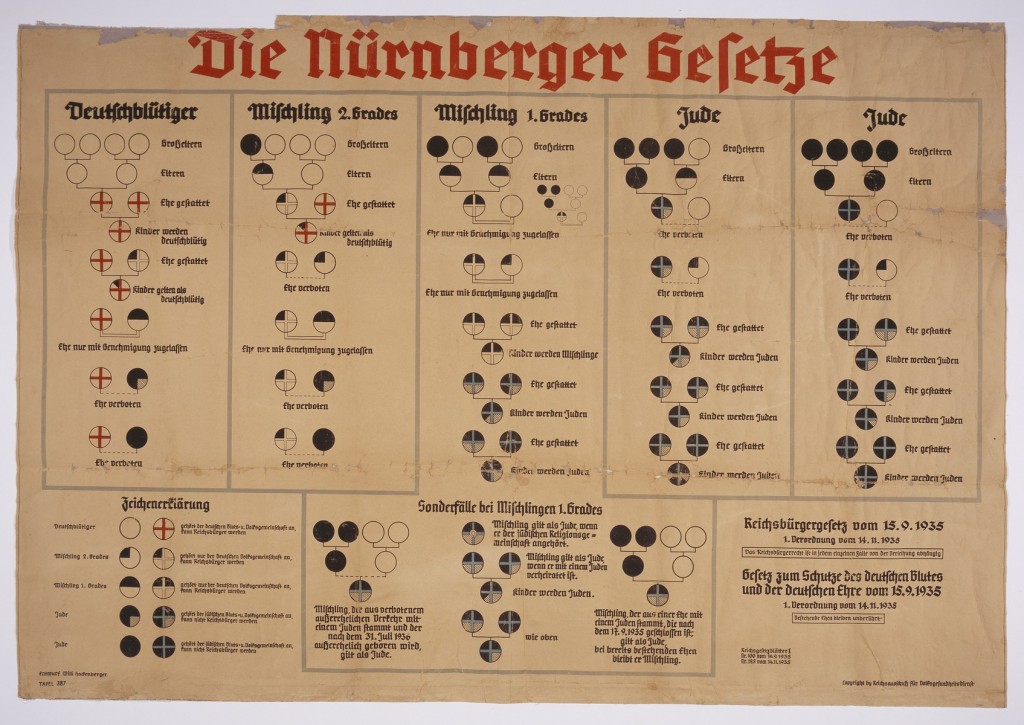
Antisemitism: An Introduction
Antisemitism is the prejudice against or hatred of Jewish people. This hatred was at the foundation of the Holocaust. But, antisemitism did not begin or end with the Holocaust. Antisemitism has existed for thousands of years. It has often taken the form of systemic discrimination against and persecution of Jews. Antisemitism has repeatedly led to serious and deadly violence against Jewish people.
Key Facts
-
1
Antisemitism is a set of hateful beliefs and ideas with deep historical, social, and cultural roots. Over many centuries, Christianity played a central role in the development and spread of antisemitism in Europe, where Jews have always been a minority.
-
2
Today, antisemitic ideas and stereotypes are held by people of all different backgrounds and religions, as well as from across the political spectrum.
-
3
Antisemitism often takes the forms of scapegoating and conspiracy theories based on stereotypes and tropes. These theories falsely portray Jewish people as dangerous to society or even the world.
Antisemitism is the prejudice against or hatred of Jewish people. It is a form of bigotry and racism. For centuries, antisemites have demonized and dehumanized Jews by spreading antisemitic tropes, stereotypes, and conspiracy theories.
Antisemitism is a set of hateful beliefs and ideas about Jews and the Jewish religion, Judaism. It is based on old and widespread prejudices. However, the word “antisemitism” is much newer. It was coined in German as “Antisemitismus” in the late 1800s. In English, antisemitism is sometimes spelled “anti-semitism,” “anti-Semitism,” or “anti semitism.”
Antisemitism drove the Holocaust. The Holocaust (1933–1945) was the systematic, state-sponsored persecution and murder of six million European Jews by Nazi Germany and its allies and collaborators. The Nazis incited people to commit genocide by drawing on centuries of antisemitic prejudices and hatreds.
But antisemitism did not begin or end with the Holocaust. For centuries, people of different religions, socio-economic statuses, political views, and national backgrounds have expressed or acted on the basis of antisemitic prejudices and beliefs. Antisemitism frequently culminates in discrimination and violence against Jews.
In Europe, anti-Jewish prejudices and hatreds date back to ancient times and to early Christianity. For centuries, Jews were a minority, often persecuted, in many European kingdoms, empires, and countries. Prejudices against Jews were a pervasive part of European life and thought during the Middle Ages (circa 500–1400); in the early modern era (circa 1400–1789); and in the 18th and 19th centuries (1700–1900) when many countries started to modernize and become more secular. By the start of the 20th century, many antisemitic stereotypes, misconceptions, and myths were well-established and widely accepted by people in Germany and other European societies. This systemic hatred made the Holocaust (1933–1945) possible.
Antisemitism’s Christian Roots
Antisemitism has its roots in the anti-Judaism of ancient times and early Christianity. Many stereotypes and conspiracies about Jews can be traced back to early and medieval Christian teachings and practices. Early Christians taught that Christianity had replaced Judaism and that Jews were no longer God’s chosen people. They claimed that Jews were stubborn and blind to the truth because they did not accept Jesus as the Messiah. These ideas shaped Christians’ mistrust and animosity toward Jews for many centuries.
Other Christian beliefs or themes that gave rise to the earliest expressions of anti-Jewish prejudices include:
- the false charge that Jews killed Jesus, which was reinforced in official Christian teachings;
- the apostle Judas Iscariot’s betrayal of Jesus as symbolic of alleged Jewish treachery and greed;
- Christian accusations of Jews as working with or being the devil; and
- false accusations of Jews performing “ritual murder” of Christian children, a lie known as “blood libel.”
These ideas are no longer actively promoted by most Christian churches and denominations. However, they influenced attitudes towards Jews for centuries. Thus, Christianity and Christian ideas about Jews formed the foundation of antisemitism.
Antisemitism became pervasive in Christian-influenced societies throughout Europe and the world, even in places where few or no Jews lived. Today, antisemitism is also widespread in societies that are not predominantly Christian.
Secular (Non-Religious) Antisemitism

Antisemitism also includes secular (non-religious) prejudices about Jews. Negative economic, nationalist, and racial ideas and beliefs about Jews developed in Europe over the course of many centuries. These secular prejudices and hatreds resulted from Jews’ position as a minority in Europe’s overwhelmingly Christian societies. Together, hateful religious and secular ideas and beliefs about Jewish people make up antisemitism.
Economic Antisemitism
Economic antisemitism is based on damaging and demeaning stereotypes that Jews are inherently greedy, stingy, or good with money. The antisemitic phrase “Jew down” (meaning, “to bargain” or “to swindle”) is a contemporary expression of this prejudice. Another example is falsely associating Jews with moneylending, banking, or finance, despite the fact that most Jews do not work in these professions.
Economic antisemitism has historical roots in medieval and early modern Europe. For centuries, many European authorities forbade Jews to own land, engage in agriculture, or work in most crafts or trades. These restrictions were typically motivated by religious prejudices. In order to earn a living, many Jewish people often had little choice but to work in commerce, moneylending, or currency exchange. For most Jewish people, their commercial occupations were small-scale endeavors, such as peddling goods. Many Jews lived in poverty. But in a very few instances, individual Jewish families became prominent and wealthy from lending money to courts or kingdoms. Such outliers gave rise to distortions and lies about Jewish wealth. These lies were built on older religious prejudices. And, in turn, they inspired secular conspiracy theories about Jews using this supposed wealth to wield power.
In the 19th century, some political figures began to incorporate economic antisemitic ideas into their political theories. For example, they included these ideas in left- and right-wing critiques of capitalism. Antisemitic political theorists blamed Jews for entire economic systems, such as capitalism and socialism. This practice continues into the 21st century, even though most capitalists, industrialists, and extremely wealthy people are not Jewish.
Nationalist Antisemitism
Nationalist antisemitism is based on damaging and demeaning stereotypes that Jews are suspicious “alien” outsiders or disloyal or unpatriotic citizens. Nationalist antisemitism also claims that Jews have dangerous and suspicious international connections. Nationalist antisemites commonly use the words “cosmopolitan” or “globalist” as coded terms for Jewish people.
Nationalist animosity towards and exclusion of Jews dates back to the late 18th and early 19th centuries. This is when nationalism became a powerful idea in Europe. Many nationalist intellectuals and writers defined the nation through shared history, language, religion, and culture. They often questioned whether Jews could be members of the nation. Drawing on these new ideas and older prejudices, many nationalists labeled Jewish people as “foreigners.”
By the late 19th century, a radical form of nationalism called ethno-nationalism became popular. Ethno-nationalism defined membership in the nation based on heredity and ethnicity. Many ethno-nationalist groups were explicitly and vocally antisemitic. They did not believe that Jews could ever become members of the nation. Ethno-nationalist political movements called for the official exclusion of Jews from economic, social, and political life. Some even advocated for the forced emigration of Jews. The growth of ethno-nationalist antisemitic political movements and associations continued into the 20th and 21st centuries. The most notable of these was the Nazi Party.
Racial Antisemitism
Racial antisemitism is based on the discriminatory and false idea that Jews are a biologically separate, inferior, or even parasitic race. It was a key component of Nazi ideology. Racial antisemitism remains a significant element of antisemitism today. People from a variety of backgrounds and with a variety of political beliefs make false claims about the supposed racial identity of Jews.
Racial antisemitism dates to the late 19th century. This is when scientific theories of race, eugenics, and Social Darwinism became popular in Europe, the United States, and elsewhere. Antisemites used these theories to give their anti-Jewish hatreds the veneer of scientific credibility. Research on DNA and the human genome proves that these ideas were incorrect. There is no scientific evidence for the existence of distinct biological races of any kind.

Antisemitic Scapegoating and Conspiracy Theories
Antisemites often use scapegoating and conspiracy theories to portray Jewish people as dangerous to society or the world. Such demonization of Jews began with early Christianity. Antisemitic scapegoating and conspiracy theories are often also based on longstanding economic, nationalist, and racist ideas about Jews.
Throughout history, antisemites have often wrongly blamed Jews for many broader problems in society. They use Jews or the Jewish people as scapegoats. Contrary to facts and reason, antisemites have falsely blamed Jews for:
- starting plagues and epidemics, such as the Black Death (bubonic plague);
- causing military losses, such as Germany’s defeat in World War I;
- spreading Communism and other radical political movements;
- orchestrating European imperialism, colonialism, and the slave trade; and
- causing financial crises, such as the Great Depression.
None of these accusations are true.
Antisemitic conspiracy theorists seek to explain major world events as the results of secret plots carried out by a shadowy group of Jews. They portray Jews as sinister “puppet masters.”
The most infamous antisemitic conspiracy theory arose around 1900 in an antisemitic publication called The Protocols of the Elders of Zion. Other such conspiracy theories include fabricated accusations that a cabal of Jewish people secretly control the media, Hollywood, or even the world.
Antisemitic scapegoating and conspiracy theories resurface and transform in times of major social, economic, and political upheaval or uncertainty. Antisemitic political groups, such as the Nazis, frequently drew on, adapted, and spread these lies to win followers.
Antisemitism in Practice
For centuries, antisemitism has shaped how non-Jewish societies and individuals treat Jewish people. Governments, religious authorities, private clubs, schools, universities, and businesses have adopted laws, practices, or policies discriminating against Jews and restricting Jewish life. Individuals have targeted Jews with vile slurs, cruel caricatures, and interpersonal violence.
Official Antisemitic Policies and Restrictions
Since ancient times, a variety of authorities in Europe and beyond have imposed restrictions on Jewish people. These restrictions were enforced by laws, decrees, and official policies of religious or government institutions. The most common ways religious or secular authorities and governments have targeted Jews have included:
- expelling Jewish people from territories (for example, from England in 1290; France in 1394; and Spain in 1492);
- visibly marking Jews using hats, badges, or symbols, including the Star of David;
- prohibiting Jews from owning land;
- levying additional taxes on Jewish people and communities;
- passing laws severely limiting job or educational opportunities for Jews, such as the numerus clausus law in Hungary in 1920;
- forcing Jewish people to convert to Christianity or Islam under the threat of death;
- refusing to allow Jews to serve in the military or government service; and
- ordering limits on where Jews can live (for example, ghettos or the Pale of Settlement created by the Russian Empire).
Societal Discrimination against Jews
For centuries, many institutions, associations, or businesses voluntarily discriminated against Jews. This type of discrimination reflected the systemic nature of antisemitism in many societies. Common forms of societal discrimination against Jews have included:
- banning Jews from membership in private clubs or professional associations (for example, guilds, 19th century German student fraternities, or 20th century American country clubs);
- refusing to allow Jews to buy property in certain areas;
- banning Jewish students from attending a university or limiting the number of Jewish students based on a quota system;
- refusing to hire Jewish employees;
- boycotting Jewish-owned businesses, such as the far-right boycott in Poland in the late 1930s; or
- spreading antisemitic lies and conspiracy theories in the press and media.
Interpersonal Expressions of Antisemitism
For centuries, antisemitic stereotypes and prejudices have shaped interactions between Jews and non-Jews. Antisemitic individuals or groups have targeted Jews by:
- using slurs or telling jokes based on antisemitic stereotypes and conspiracy theories;
- caricaturing or describing Jewish people as having hooked noses or other disfigured features;
- depicting Jews as sexual predators or carriers of disease;
- dehumanizing Jews in art or other images by depicting them as pigs, vermin, octopuses, or other animals;
- labeling people or ideas as Jewish in order to make them a target for abuse;
- vandalizing, burning, or otherwise desecrating synagogues, cemeteries, schools, or other Jewish religious or communal spaces; and
- beating, attacking, or even murdering individuals based on their perceived Jewishness.
While antisemitic policies and restrictions are less common today, expressions of anti-Jewish prejudices still occur on streets, in political discourse, in churches, mosques, campuses and classrooms, in the press, and on social media and the radio.
Mass Violence Targeting Jews
Antisemitism has often culminated in mass violence targeting Jewish people. Antisemitic scapegoating and conspiracy theories have frequently motivated antisemites to target Jewish people with violence. The fact that Jewish people were a minority in Europe left them vulnerable to vicious attacks.
Some of the most notorious examples of mass violence targeting Jewish people before the Holocaust include:
- massacres of entire Jewish communities by Christian soldiers during the Crusades in the Middle Ages;
- torture and execution of Jews by Catholic Spanish officials during the Spanish Inquisition (1478–1834);
- riots targeting Jewish communities perpetrated across Europe by local mobs in response to accusations of blood libel, typically linked to the Christian Easter and Jewish Passover holidays; and
- pogroms (often deadly anti-Jewish riots) perpetrated by soldiers, police, and local mobs in eastern Europe in the late 19th and early 20th centuries.
The scale of antisemitic mass violence and murder during the Holocaust (1933–1945) was in a category of its own. The Nazis and their allies and collaborators murdered six million Jews in this systematic, state-sponsored genocide. The Nazis incited people to commit genocide by drawing on centuries of antisemitic prejudices and hatreds.
But the Holocaust did not mark the end of antisemitic mass violence. Antisemitic violence remains a threat to Jewish people and organizations throughout the world.
Holocaust Distortion and Denial as Forms of Antisemitism
Holocaust denial and distortion are newer forms of antisemitism.
- Holocaust denial is any attempt to negate the established facts of the Nazi German genocide of European Jews.
- Holocaust distortion is any statement that misrepresents established facts about the Holocaust.
Holocaust denial and distortion exploit and update older antisemitic stereotypes. People who spread these irrational theories claim that the Holocaust was invented or exaggerated by Jews in order to advance their own interests.
In the late 20th and 21st centuries, some antisemites misuse or exploit the documented history of the Holocaust by:
- using Nazi symbols (especially the swastika) to intimidate or terrorize Jewish people;
- threatening Jewish people with references to gas chambers or ovens;
- drawing analogies between the State of Israel and Nazi Germany; and
- making comparisons that distort, downplay, or trivialize the documented crimes committed during Holocaust.
A Multifaceted and Enduring Hatred
Antisemitism is a set of hateful beliefs and ideas with deep historical, social, and cultural roots. Today, antisemitic ideas and stereotypes are held by people from many different religious, ethnic, and social backgrounds and from across the political spectrum, including both the left and the right. They deploy hateful antisemitic tropes, stereotypes, and conspiracy theories to further their ideological agendas. In doing so, they demonize and dehumanize Jews.
Antisemitism often starts as rhetoric—with slurs, scapegoating, or insults. But history has demonstrated that antisemitism can escalate to broader discrimination, dehumanization, mass violence, and genocide.
Footnotes
-
Footnote reference1.
This is called “supersessionism” or “replacement theology.”
-
Footnote reference2.
For centuries, many Christians believed that Jews committed deicide by killing Jesus. In fact, Jesus was killed by Roman authorities. The leaders of various Christian traditions reinforced this false belief in their official teachings. It was not until the late 20th century that some Christian churches condemned the charge of deicide as false. For example, the Roman Catholic Church repudiated these lies as part of the Second Vatican Council in 1965.
-
Footnote reference3.
Many Christian anti-Jewish stereotypes can be traced back to the first century figure of Judas Iscariot, who, like Jesus, was Jewish. In Christian scripture, Judas betrays Jesus in exchange for 30 pieces of silver. In Christian-dominated Europe, this portrayal transformed into a hateful stereotype of Jews, as symbolized by Judas, as treacherous and greedy.
-
Footnote reference4.
In the late Middle Ages and early modern period, many Christians accused Jews of working with or even being the devil. These assertions became an accepted part of Christian treatises, theology, morality plays, folk tales, and art. Notably, Martin Luther, the theologian who initiated the Protestant Reformation in 1517, wrote an offensive treatise about Jews in 1543. Enraged that Jews did not convert to Christianity in the wake of the Reformation, he hostilely labeled Jews as descendants of the devil. Christian artists often depicted Jews as the devil or as animal-like figures with horns, claws, jagged teeth, and/or cloven feet.
Critical Thinking Questions
Jews were less than 1 percent of the population in Germany in 1933. How and why was antisemitism so important to the Nazi platform and its eventual success?
How can deep-seated hatreds be countered?

